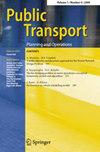Merging transport network companies and taxis in Curitiba’s BRT system
IF 2.3
Q2 TRANSPORTATION SCIENCE & TECHNOLOGY
引用次数: 0
Abstract
Abstract The Brazilian city of Curitiba became known around the world for pioneering bus rapid transit (BRT) in the 1970s. Five decades later, public transport ridership is declining on the city’s bus-based system. One-person car trips and car ownership are soaring, and services provided by transport network companies rapidly proliferate and then disappear as congestion worsens and expands across the road network. This was the macro-scale scenario for mobility and modal trends in Curitiba until COVID-19 brought things to a screeching halt in 2020. The widespread use of information and communication technologies has allowed taxi and car ride-hailing transport network schemes to emerge while blurring the lines between public and private and individual and collective transport, locally as well as globally. In 2016, transport network company systems, apps, private cars, services, drivers and passengers disrupted Curitiba’s longstanding and well-regulated taxi system and market for licenses. In 2023, hailing a cab or a shared ride feels and costs the same for passengers (now customers). This study investigates whether these actors and technologies compete with or complement each other in this city, locating and quantifying the benefits for passengers of merging taxi and car ridesharing with the BRT system as first- and last-mile transport to and from BRT corridors. We developed mobile information and communication technologies and acquired, processed, and analyzed millions of data points for passenger location on BRT, ordinary bus, and taxi trips at the city scale. The shareability index for Curitiba’s taxi or car rides was calculated, demonstrating that 60% of all taxi trips have the potential to serve as first- and last-mile transport solution to and from the BRT terminals, stations, and corridors and that nearly 40% of taxi trips both originate and end near (< 500 m) this BRT system infrastructure. By envisioning how transport network companies could merge into the built environment thanks to urban transport digitization, we have developed a model for integrating public transport with the analytic framework of transport network companies that could be deployed in other cities with similar challenges related to public transport, sociotechnical arrangements, system complexity, policymaking, and planning.合并库里蒂巴快速公交系统中的交通网络公司和出租车
上世纪70年代,巴西库里蒂巴市以其快速公交系统(BRT)的先驱而闻名于世。五十年后,城市公交系统的公共交通乘客数量正在下降。单人驾车出行和汽车保有量正在飙升,交通网络公司提供的服务迅速激增,然后随着交通拥堵的恶化和在整个道路网络中的扩展而消失。这是库里蒂巴的流动性和模式趋势的宏观情景,直到2020年COVID-19使这一切戛然而止。信息和通信技术的广泛使用使出租车和汽车叫车交通网络计划得以出现,同时模糊了地方和全球公共和私人、个人和集体交通之间的界限。2016年,交通网络公司系统、应用程序、私家车、服务、司机和乘客扰乱了库里蒂巴长期以来监管良好的出租车系统和牌照市场。2023年,对乘客(现在是客户)来说,叫出租车或拼车的感觉和成本是一样的。本研究调查了这些参与者和技术在这个城市是相互竞争还是互补,定位和量化了将出租车和汽车拼车与BRT系统合并作为往返BRT走廊的第一英里和最后一英里交通工具对乘客的好处。我们开发了移动信息和通信技术,并获取、处理和分析了数百万个数据点,用于城市规模的快速公交、普通公交和出租车出行的乘客位置。对库里蒂巴出租车或汽车出行的可共享性指数进行了计算,结果表明,60%的出租车出行有潜力成为往返BRT终端、车站和走廊的第一英里和最后一英里交通解决方案,近40%的出租车出行出发地和终点都在(<500米)的快速公交系统基础设施。通过设想交通网络公司如何通过城市交通数字化融入建筑环境,我们开发了一个模型,将公共交通与交通网络公司的分析框架整合在一起,该模型可以应用于其他城市,这些城市面临着与公共交通、社会技术安排、系统复杂性、政策制定和规划相关的类似挑战。
本文章由计算机程序翻译,如有差异,请以英文原文为准。
求助全文
约1分钟内获得全文
求助全文
来源期刊

Public Transport
TRANSPORTATION SCIENCE & TECHNOLOGY-
CiteScore
5.40
自引率
15.40%
发文量
19
期刊介绍:
The scope and purpose of the journal includes, but is not limited to, any type of research in the area of Public Transport: Planning and Operations. As its core it serves the primary mission of advancing the state of the art and the state of the practice in computer-aided systems and scheduling in public transport. The journal considers any type of subjects in this area especially with a focus to planning and scheduling, the common ground is the use of computer-aided methods and operations research techniques to improve information management, network and route planning, vehicle and crew scheduling and rostering, vehicle monitoring and management, and practical experience with scheduling and public transport planning methods. Besides theoretical papers, the journal also publishes case studies and applications. Public Transport addresses transport operators, consulting firms and academic institutions involved in development, utilization or research of computer-aided planning and scheduling in public transport.Officially cited as: Public Transp
 求助内容:
求助内容: 应助结果提醒方式:
应助结果提醒方式:


